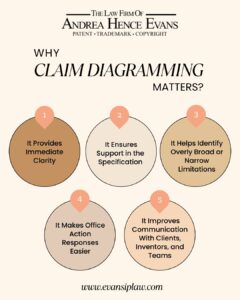1. It Provides Immediate Clarity
Patent claims are written as long, uninterrupted sentences. Diagramming breaks them into understandable parts, making it easier to identify:
-
Required elements
-
Optional elements
-
Functional relationships
-
Support in the specification
This clarity improves both drafting and internal review.
2. It Ensures Support in the Specification
A well-diagrammed claim highlights where support may be lacking. If a key limitation is not clearly described or illustrated in the spec, you can fix the issue before filing.
3. It Helps Identify Overly Broad or Narrow Limitations
Visualizing each component allows you to quickly test the claim’s breadth. You can ask:
-
“Is this limitation necessary?”
-
“Does this add value, or does it limit scope unnecessarily?”
-
“Is there room for additional dependent claims?”
This analysis helps create stronger, more strategic claim sets.
4. It Makes Office Action Responses Easier
When faced with a §102 or §103 rejection, claim diagramming makes it easier to compare your claims to prior art. You can rapidly spot:
-
Missing elements in the prior art
-
Differences in structure or function
-
Opportunities for amendments
This saves time and reduces errors.
5. It Improves Communication With Clients, Inventors, and Teams
Not everyone speaks “patent claim.” Diagramming helps you communicate the claim’s structure to:
-
Inventors
-
In-house counsel
-
Litigation teams
-
Business stakeholders
It’s a powerful teaching tool.

